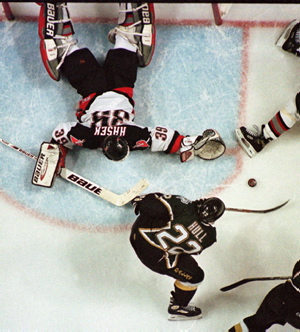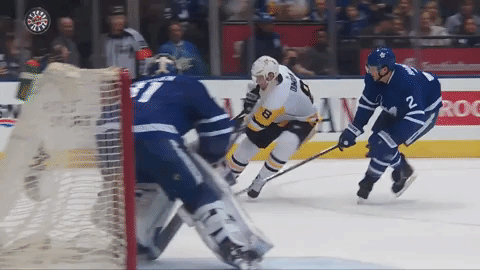69 is sucking the life out of hockey.
On Saturday night in Game 69, the Penguins were the latest team on the wrong end of 69 – Rule 69: Interference on the Goalkeeper. While there were other reasons the Pens lost in Toronto, it was a key moment in the game. As Pensblog brother G-Off wrote in yesterday’s Leafs Quickcap/Stars Gameday: “Gotta put it behind you and get the two points tonight.” On a night when the Pens controlled more than 62% of shots on goal, shot attempts and scoring chances at 5-on-5, opportunities abounded to put the puck in the net. However, the Leafs capitalized at even strength and especially on special teams: 2 for 2 on the power play while killing all three of Pittsburgh’s chances.
But back to Rule 69. It’s one thing when fans and media have trouble interpreting this rule but when NHL coaches and players are still having difficulty understanding what is and is not goaltender interference with four weeks to go before the playoffs, then the NHL has a serious problem either with the way the rule is written or the way referees are applying it.
[youtube https://www.youtube.com/watch?v=kBriOtvkybk]Stationed on the far side of the ice, along the goal line, referee Dean Morton immediately waved off the goal and just as quickly assessed a minor penalty to Dumoulin for goaltender interference.
The unusual part of this particular play from the Penguins’ perspective is that Morton rushed to both wave off the goal and make that penalty call before consulting the other officials. Even after speaking to an understandably pissed-off Sullivan and finally conferencing with the second referee and linesmen, Morton stuck with his no-goal call. Hockey Night in Canada told viewers that this play was not reviewable since the goal was waved off and a goalie interference penalty was assessed, but if I’m reading Rules 69, 78 and Reference Table 16 of the NHL Official Rules correctly, there is actually a provision that allows for this exact type of play to be challenged and reviewed. Here are the relevant parts:
Rule 69.1 Interference on the Goalkeeper: … If an attacking player has been pushed, shoved, or fouled by a defending player so as to cause him to come into contact with the goalkeeper, such contact will not be deemed contact initiated by the attacking player for purposes of this rule, provided the attacking player has made a reasonable effort to avoid such contact.
On replay, we can clearly see Dumoulin’s former defense partner Ron Hainsey giving a gentle, but significant shove to Dumoulin’s back that moved the Penguin closer to Andersen. Moreover, Hainsey skates behind Dumoulin trapping him in the crease. After Dumoulin sweeps the puck past Andersen’s right pad, Dumoulin raises his right leg to avoid contact with Andersen’s left pad but Dumoulin’s right elbow hits Andersen’s head. If Hainsey hadn’t pushed him, would Dumoulin really have been skating within contact distance of Andersen?
Rule 78.7 Coach’s Challenge (ii) Scoring Plays Involving Potential “Interference on the Goalkeeper” … (b) A play that results in a “NO GOAL” call on the ice despite the puck having entered the net, where the On-Ice Officials have determined that the attacking team was guilty of “Interference on the Goalkeeper” but where the attacking team asserts … (ii) the attacking Player was pushed, shoved, or fouled by a defending Player causing the attacking Player to come into contact with the goalkeeper…
(d) The standard for overturning the call in the event of a “NO GOAL” call on the ice is that the Referee, after reviewing any and all replays and consulting with the NHL Situation Room, determines that the goal on the ice should have been allowed because … (ii) the attacking Player was pushed, shoved or fouled by a defending Player causing the attacking Player to come into contact with the goalkeeper…
Reference Table 16 Interference on the Goalkeeper Situations: … 3. A PLAYER PUSHES, SHOVES, OR FOULS ANOTHER PLAYER INTO THE
GOALKEEPER, WHO IS IN OR OUT OF THE CREASE. A. The attacking player, after having made a reasonable effort to avoid contact, makes contact with the goalkeeper at the time a goal is scored: Goal is allowed.

In the grand scheme of things, this was one play, but of course, the overall additive effect on the NHL’s image is starting to become significant as teams struggle to understand the application of the goalie interference rule.
One can imagine where this is headed: 2018 Stanley Cup Final Game 7. Overtime. Every hockey fan in North America and worldwide is watching a similar play unfold. Jostling in front of the net. Contact between the defenseman, the puck carrier and the goalie. The puck enters the net.
The officials confer, skate to the boards and put on the headset, sending the play to Hockey Operations for video review as fans loudly groan…
It’s been 19 years since the “Brett Hull Skate in Crease” fiasco. Will we see another Stanley Cup champion decided on a Video Review rules interpretation?
One more thing:
Among active referees since start of 2005-06 season, Pens have their worst record (19-26-5, 43.0 %) in games worked by Dean Morton. Guess who made that call.
— Bob Grove (@bobgrove91) March 11, 2018
That Grover compiled this data and posted it 20 minutes after the play is nothing short of a Hall of Fame effort.
Add The Sports Daily to your Google News Feed!

